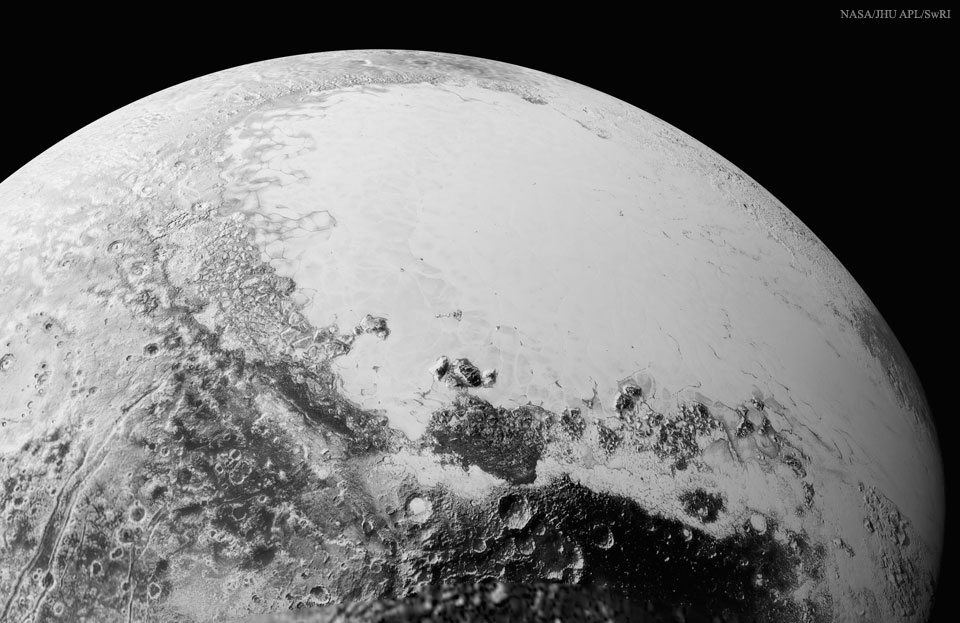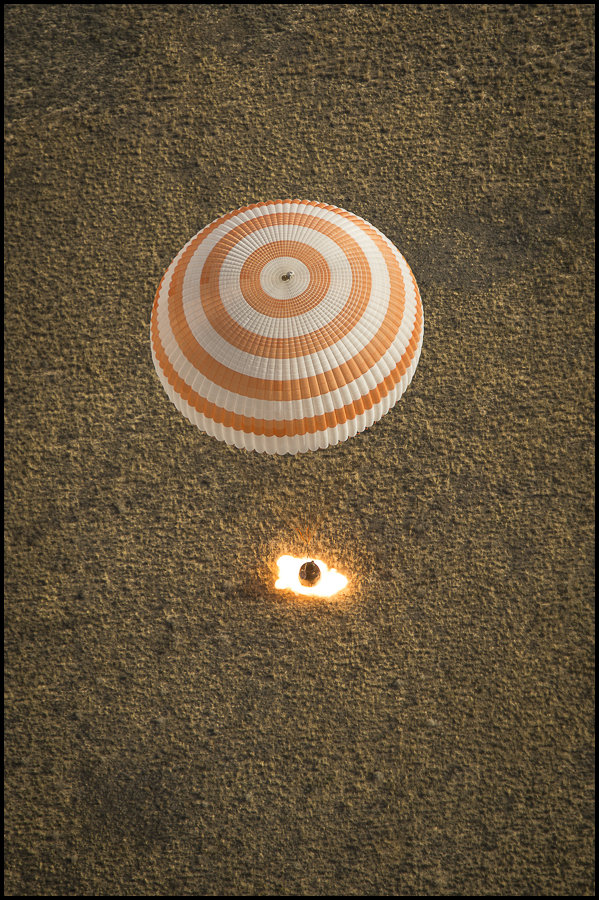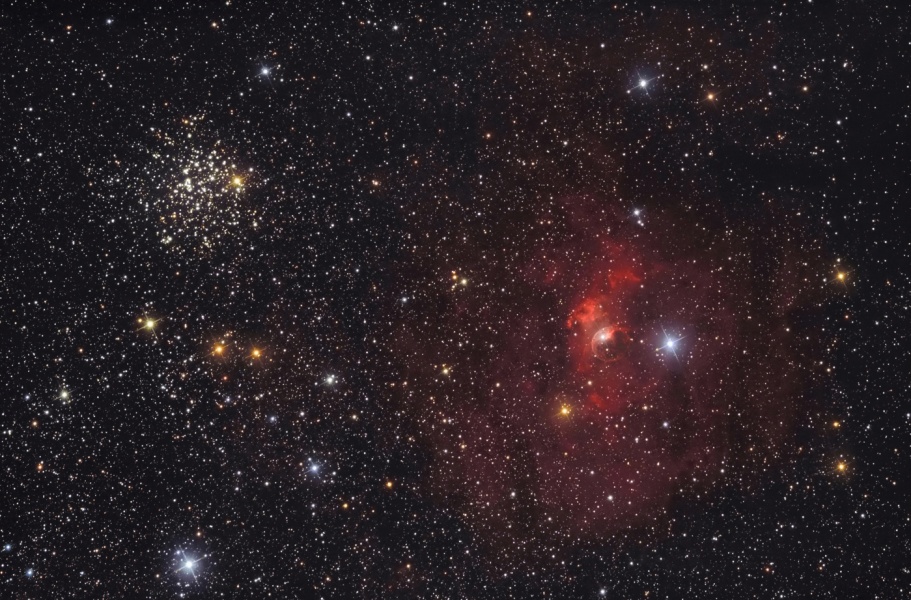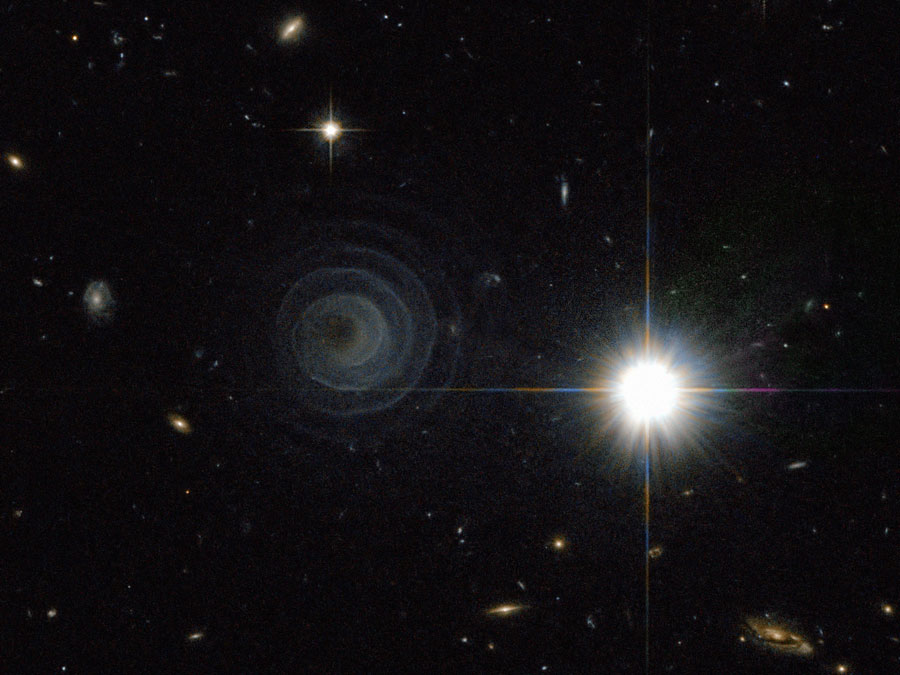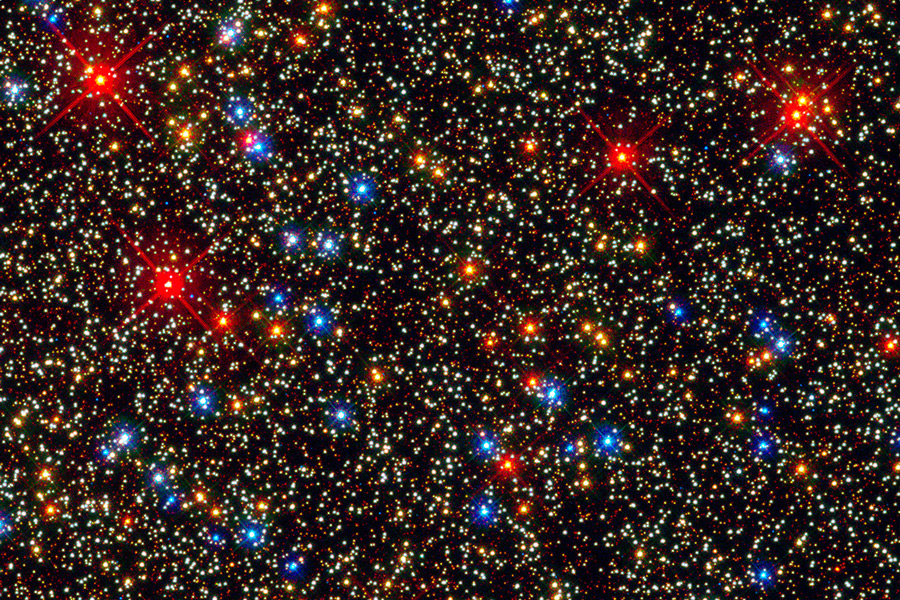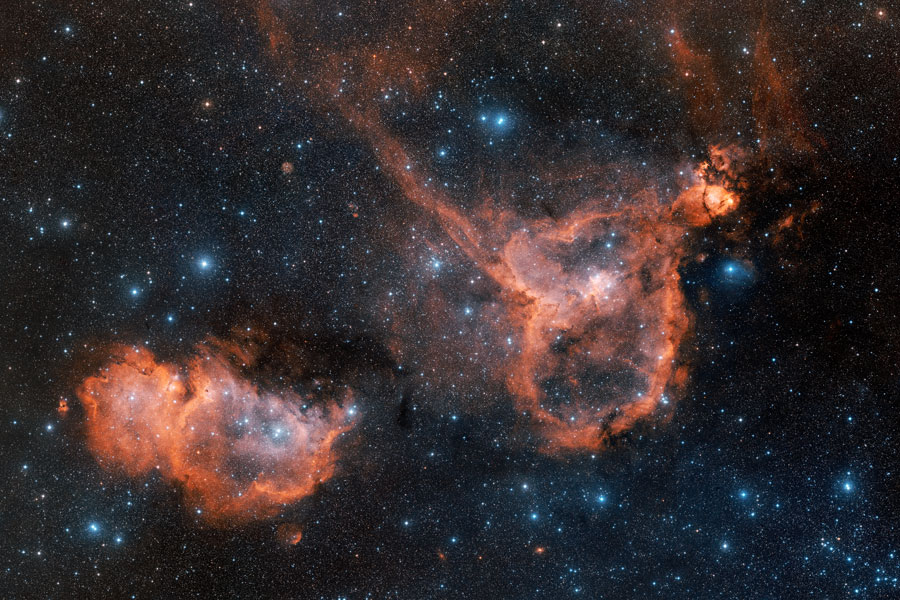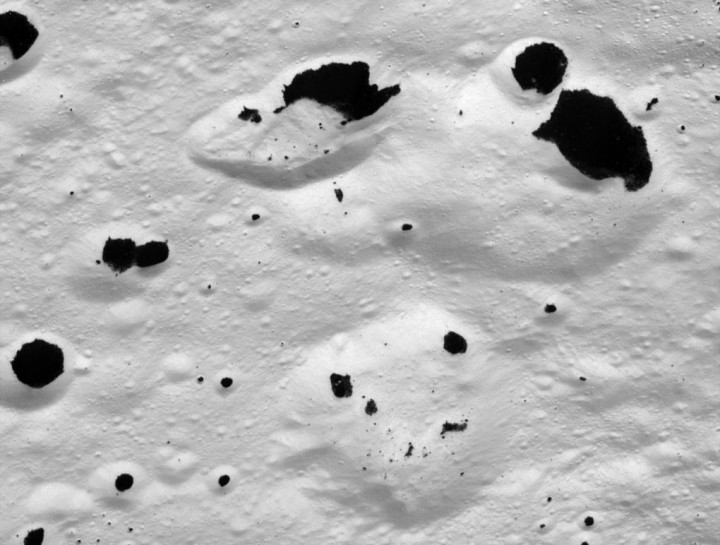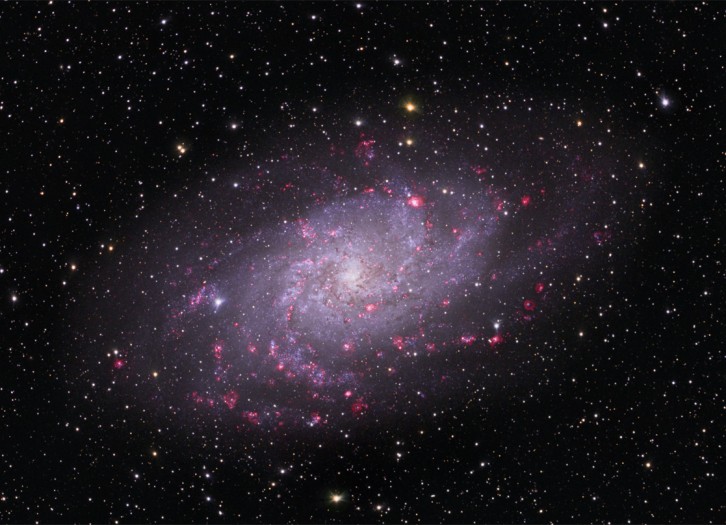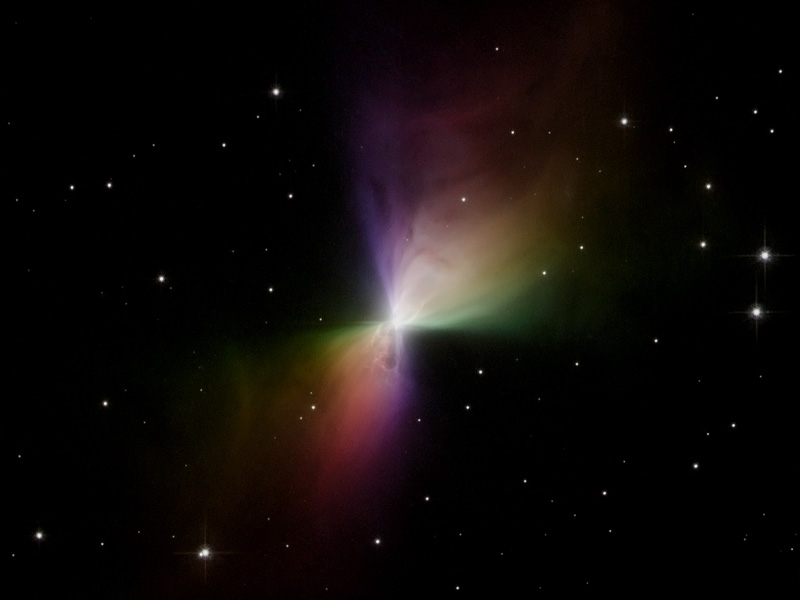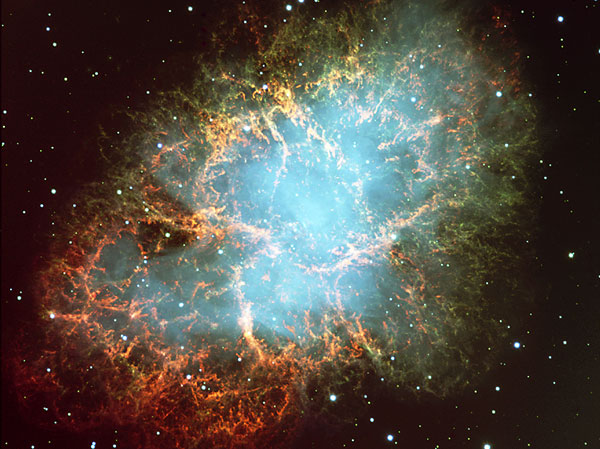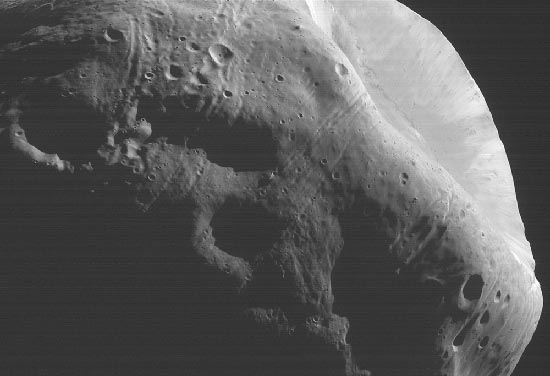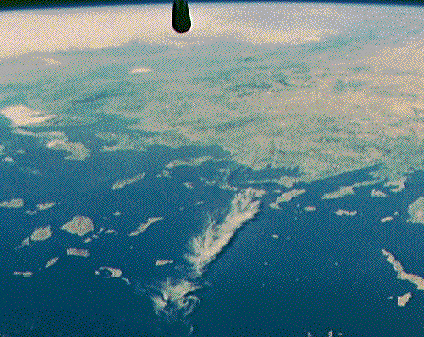| << Previous | Index | Next >> |
2015 New high resolution images of Pluto are starting to arrive from the outer Solar System. The robotic New Horizons spacecraft, which zoomed by Pluto in July, has finished sending back some needed engineering data and is now transmitting selections from its tremendous storehouse of images of Pluto and its moons. The featured image, a digital composite, details a surprising terrain filled with craters, plains, landscape of unknown character, and landforms that resemble something on Earth but are quite unexpected on Pluto. The light area sprawling across the upper right has been dubbed Sputnik Planum and is being studied for its unusual smoothness, while the dark cratered area just under the spacecraft is known as Cthulhu Regio. So far, New Horizons has only shared a few percent of the images and data it took during its Pluto flyby, but will continue to send back new views of the dwarf planet even as it glides outward toward even more distant explorations.
2014 The first hint of what will become of our Sun was discovered inadvertently in 1764. At that time, Charles Messier was compiling a list of diffuse objects not to be confused with comets. The 27th object on Messier's list, now known as M27 or the Dumbbell Nebula, is a planetary nebula, the type of nebula our Sun will produce when nuclear fusion stops in its core. M27 is one of the brightest planetary nebulae on the sky, and can be seen toward the constellation of the Fox (Vulpecula) with binoculars. It takes light about 1000 years to reach us from M27, shown above in colors emitted by hydrogen and oxygen. Understanding the physics and significance of M27 was well beyond 18th century science. Even today, many things remain mysterious about bipolar planetary nebula like M27, including the physical mechanism that expels a low-mass star's gaseous outer-envelope, leaving an X-ray hot white dwarf.
2013 With parachute deployed and retro-rockets blazing, this spacecraft landed on planet Earth on September 11 (UT) in a remote area near the town of Zhezkazgan, Kazakhstan. Seen in silhouette against the rockets' glare, the spacecraft is a Soyuz TMA-08M. Its crew, Expedition 36 Commander Pavel Vinogradov and Flight Engineer Alexander Misurkin of the Russian Federal Space Agency (Roscosmos), and Flight Engineer Chris Cassidy of NASA were returning after five and half months aboard the International Space Station. The Soyuz retro-rockets fire very quickly and for an extremely short duration near touchdown. Capturing the moment, the well-timed photograph was taken from a helicopter flying over the landing site.
2012 Giant elliptical galaxy M60 and spiral galaxy NGC 4647 do look like an odd couple in this sharp cosmic portrait from the Hubble Space Telescope. But they are found in a region of space where galaxies tend to gather, on the eastern side of the nearby Virgo Galaxy Cluster. About 54 million light-years distant, bright M60's simpler egg-like shape is created by its randomly swarming older stars, while NGC 4647's young blue stars, gas and dust are organized into winding arms rotating in a flattened disk. Spiral NGC 4647 is estimated to be more distant than M60, some 63 million light-years away. Also known as Arp 116, the pair of galaxies may be on the verge of a significant gravitational encounter, though. M60 (aka NGC 4649) is about 120,000 light-years across. The smaller NGC 4647 spans around 90,000 light-years, about the size of our own Milky Way.
2011 To the eye, this cosmic composition nicely balances the Bubble Nebula at the lower right with open star cluster M52. The pair would be lopsided on other scales, though. Embedded in a complex of interstellar dust and gas and blown by the winds from a single, massive O-type star, the Bubble Nebula, also known as NGC 7635, is a mere 10 light-years wide. On the other hand, M52 is a rich open cluster of around a thousand stars. The cluster is about 25 light-years across. Seen toward the northern boundary of Cassiopeia, distance estimates for the Bubble Nebula and associated cloud complex are around 11,000 light-years, while star cluster M52 lies nearly 5,000 light-years away. The wide telescopic field of view spans about 1.5 degrees on the sky or three times the apparent size of the Full Moon.
2010 What created the strange spiral structure on the left? No one is sure, although it is likely related to a star in a binary star system entering the planetary nebula phase, when its outer atmosphere is ejected. The huge spiral spans about a third of a light year across and, winding four or five complete turns, has a regularity that is without precedent. Given the expansion rate of the spiral gas, a new layer must appear about every 800 years, a close match to the time it takes for the two stars to orbit each other. The star system that created it is most commonly known as LL Pegasi, but also AFGL 3068. The unusual structure itself has been cataloged as IRAS 23166+1655. The above image was taken in near-infrared light by the Hubble Space Telescope. Why the spiral glows is itself a mystery, with a leading hypothesis being illumination by light reflected from nearby stars.
2009 What is left over after stars collide? To help answer this question, astronomers have been studying the center of the most massive ball of stars in our Milky Way Galaxy. In the center of globular cluster Omega Centauri, stars are packed in 10,000 times more densely than near our Sun. Pictured above, the newly upgraded Hubble Space Telescope has resolved the very center of Omega Centauri into individual stars. Visible are many faint yellow-white stars that are smaller than our Sun, several yellow-orange stars that are Red Giants, and an occasional blue star. When two stars collide they likely either combine to form one more massive star, or they stick, forming a new binary star system. Close binary stars interact, sometimes emitting ultraviolet or X-ray light when gas falls from one star onto the surface of a compact companion such as a white dwarf or neutron star. Two such binaries have now been located in Omega Centauri's center. The star cluster lies about 15,000 light-years away and is visible toward the constellation of Centaurus.
2008
2007 Iapetus, Saturn's third largest moon, is a candidate for the strangest moon of Saturn. Tidally locked in its orbit around the ringed gas giant, Iapetus is sometimes called the yin-yang moon because its leading hemisphere is very dark, reflecting about 5 percent of the Sun's light, while its trailing hemisphere is almost as bright as snow. This recent Cassini spacecraft flyby image is one of the closest views ever. It spans about 35 kilometers across a cratered transition zone between bright and dark terrain. Iapetus itself has a density close to that of water ice, but the detailed reflective properties of the dark material suggest an organic composition. Honoring the moon's discoverer, the dark terrain is called Cassini Regio.
2006 The small, northern constellation Triangulum harbors this magnificent face-on spiral galaxy, M33. Its popular names include the Pinwheel Galaxy or just the Triangulum Galaxy. M33 is over 50,000 light-years in diameter, third largest in the Local Group of galaxies after the Andromeda Galaxy (M31), and our own Milky Way. About 3 million light-years from the Milky Way, M33 is itself thought to be a satellite of the Andromeda Galaxy and astronomers in these two galaxies would likely have spectacular views of each other's grand spiral star systems. As for the view from planet Earth, this detailed, wide field image nicely shows off M33's blue star clusters and pinkish star forming regions which trace the galaxy's loosely wound spiral arms. In fact, the cavernous NGC 604 is the brightest star forming region, seen here at about the 1 o'clock position from the galaxy center. Like M31, M33's population of well-measured variable stars have helped make this nearby spiral a cosmic yardstick for establishing the distance scale of the Universe.
2005 Why did the Boomerang Nebula form? The symmetric cloud dubbed the Boomerang appears to have been created by a high-speed wind of gas and dust blowing from an aging central star at speeds of nearly 600,000 kilometers per hour. What confines the wind remains a mystery though -- it may be a central disk of dense gas or a central magnetic field. The rapid expansion itself, however, has cooled molecules in the nebular gas to about one degree above absolute zero - colder than even the cosmic background radiation - making it the coldest known region in the distant Universe. Shining with light from the central star reflected by dust, the frigid Boomerang Nebula is believed to be a star or stellar system evolving toward the planetary nebula phase. To help better understand the Boomerang's origin, astronomers are studying the above image taken in polarized light, color coded by an angular direction associated with the polarization. Different progenitor scenarios create different amounts and patterns of polarized light. The above image was taken by the Hubble Space Telescope's Advanced Camera for Surveys earlier this year. The Boomerang Nebula spans about one light year and lies about 5,000 light years away toward the constellation Centaurus.
2004 A flying saucer from outer space crash-landed in the Utah desert last week after being tracked by radar and chased by helicopters. No space aliens were involved, however. The saucer, pictured above, was the Genesis sample return capsule, part of a human-made robot Genesis spaceship launched three years ago by NASA itself to study the Sun. The unexpectedly hard landing at over 300 kilometers per hour occurred because the parachutes did not open as planned. The Genesis mission had been orbiting the Sun collecting solar wind particles that are usually deflected away by Earth's magnetic field. A big question remains -- are the returned samples in good enough condition to recover information about the real composition of the Sun? Genesis team scientists and engineers are working hard to find out.
2003 The Crab Nebula, filled with mysterious filaments, is the result of a star that was seen to explode in 1054 AD. This spectacular supernova explosion was recorded by Chinese and (quite probably) Anasazi Indian astronomers. The filaments are mysterious because they appear to have less mass than expelled in the original supernova and higher speed than expected from a free explosion. In the above picture taken recently from a Very Large Telescope, the color indicates what is happening to the electrons in differentparts of the Crab Nebula. Red indicates the electrons are recombining with protons to form neutral hydrogen, while blue indicates the electrons are whirling around the magnetic field of the inner nebula. In the nebula's very center lies a pulsar: a neutron star rotating, in this case, 30 times a second.
2002 This x-ray image of the Moon was made by the orbiting ROSAT (Röntgensatellit) Observatory in 1990. In this digital picture, pixel brightness corresponds to x-ray intensity. Consider the image in three parts: the bright hemisphere of the x-ray moon, the darker half of the moon, and the x-ray sky background. The bright lunar hemisphere shines in x-rays because it scatters x-rays emitted by the sun. The background sky has an x-ray glow in part due to the myriad of distant, powerful active galaxies, unresolved in the ROSAT picture but recently detected in Chandra Observatory x-ray images. But why isn't the dark half of the moon completely dark? It's true that the dark lunar face is in shadow and so is shielded from direct solar x-rays. Still, the few x-ray photons which seem to come from the moon's dark half are currently thought to be caused by energetic particles in the solar wind bombarding the lunar surface.
2001 Stars are born in M16's Eagle Nebula, a stellar nursery 7,000 light-years from Earth toward the constellation Serpens. The striking nebula's star forming pillars of gas and dust are familiar to astronomers from images at visible wavelengths, but this false-color picture shows off the nebula in infrared light. Data from ESA's Infrared Space Observatory satellite (ISO) was used to construct the detailed two color image, dominated by infrared emission from clouds of interstellar material at temperatures below -100 degrees Celsius. Blue colors highlight emission thought to indicate the presence of complex carbon molecules, known on planet Earth as PAHs, while red colors trace emission from cold, microscopic dust grains. Hot young stars are formed as this frigid material condenses under the influence of gravity. Once begun, the process takes only tens of thousands of years for truly massive stars and up to tens of millions of years for low mass stars like the Sun.
2000 Black holes are probably the most bizarre creatures in the modern astronomical zoo. And after years of pondering black holes as either stellar mass objects seen in binary star systems or enormous supermassive black holes at the centers of galaxies, astronomers now have strong evidence for another exotic species -- middle mass black holes. The leading candidate for the ultradense middle ground is indicated in this false-color detail of a sharp x-ray picture from the space-based Chandra Observatory. A close-up of x-ray sources near the center of starburst galaxy M82, the cropped Chandra image spans about 4,000 light-years. M82 itself is around 11 million light-years distant. The arrowed source has recently been convincingly demonstrated to exhibit x-ray characteristics of an object whose gravitational field holds more than 500 times the mass of the sun within a volume the size of the moon! Astronomers also note that unlike the supermassive variety which are thought to lie at the centers of galaxies, this middle mass black hole is about 600 light-years from the center of M82. Theories for the formation of a middle mass black hole include the collapse of a "hyperstar" formed by the coalescence of many normal stars, or the direct merger of stellar mass black holes.
1999 The Great Nebula in Orion is a colorful place. Visible to the unaided eye as a fuzzy patch in the constellation of Orion, this image taken with the Big Throughput Camera shows the Orion Nebula to be a busy neighborhood of young stars, hot gas, and dark dust. The power behind much of the Orion Nebula (M42) is the Trapezium - four of the brightest stars in the nebula. The eerie blue glow surrounding the bright stars pictured here is their own starlight reflected by nearby dust. Hot oxygen and hydrogen gases cause the extended green and pink glows, respectively. Dark brown dust filaments cover much of the region. The whole Orion Nebula cloud complex, which includes the Horsehead Nebula, will slowly disperse over the next 100,000 years.
1998 Landing on the Martian Moon Phobos might be harder than previously thought. The reason: Moon dust. Recent photographs of Phobos have indicated that a layer of fine powder estimated to be a meter deep covers the whole surface. Evidence comes from infrared pictures that indicate the rapid speed that Phobos' surface cools after sunset. The above high-resolution picture of Phobos was taken last month by the Mars Global Surveyor spacecraft now orbiting Mars. The larger of two Martian moons, measures about 20 kilometers across, and orbits so close that Mars' gravity should rip it apart in another 50 million years.
1997 The sands of time are running out for the central star of this hourglass-shaped planetary nebula. With its nuclear fuel exhausted, this brief, spectacular, closing phase of a Sun-like star's life occurs as its outer layers are ejected - its core becoming a cooling, fading white dwarf. Astronomers have recently used the Hubble Space Telescope (HST) to make a series of images of planetary nebulae, including the one above. Here, delicate rings of colorful glowing gas (nitrogen-red, hydrogen-green, and oxygen-blue) outline the tenuous walls of the "hourglass". The unprecedented sharpness of the HST images has revealed surprising details of the nebula ejection process and may help resolve the outstanding mystery of the variety of complex shapes and symmetries of planetary nebulae.
1996 Here lived one of the greatest thinkers in human history. Aristarchus lived on the Greek island of Samos, a small island in the center of the above picture that can be identified with a good map. Aristarchus, who lived from 310 BC to 230 BC, postulated that the planets orbited the Sun - not the Earth -- over a thousand years before Copernicus and Galileo made similar arguments. Aristarchus used clear logic to estimate the size of the Earth, the size and distance to our Moon, the size and distance to our Sun, the the even deduced that the points of light we see at night are not dots painted on some celestial sphere but stars like our Sun at enormous distances. Aristarchus' discoveries remained truly unbelievable to the people of his time but stand today as pillars of deductive reasoning.
1995 This historic picture was humanity's first glimpse of the far side of the Moon. It was taken by the Soviet spacecraft Luna 3 in October of 1959. Luna 3 followed closely on the heels of another Soviet probe, Luna 2, which had become the first spacecraft to impact the Moon on September 13th of that same year.
Why does the Moon have a far side? Gravitational tidal forces within the Earth-Moon system have synchronized the Moon's period of rotation around its axis with its orbital period at about 28 days. So, as the Moon moves around its orbit its rotation exactly compensates, keeping the same face toward the Earth.
| << Previous | Index | Next >> |
